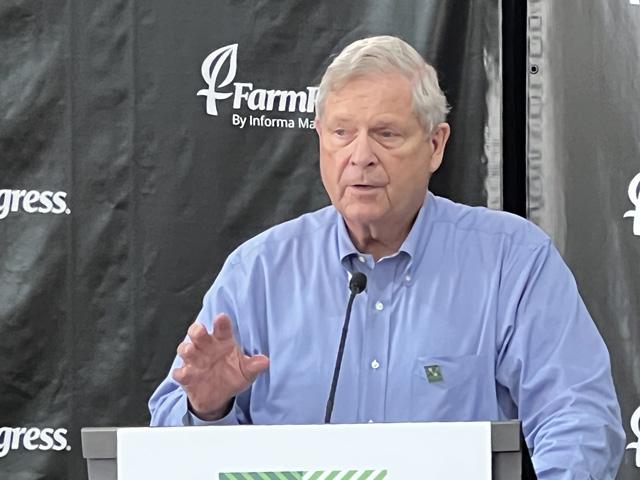Ag Secretary Visits Farm Progress Show
USDA Unsure About Status of Weekly Export Report as Vilsack Touts Climate Initiatives
BOONE, Iowa (DTN) -- Agriculture Secretary Tom Vilsack said Tuesday he's not sure if the Foreign Agricultural Service (FAS) will be able to release its normal Weekly Export Sales and Shipments report on Thursday.
Programming problems with the launch of a new sales data tool last week forced FAS to take down and retract some of the data released.
"We're going to make sure we've got it fixed and I appreciate the fact when they made the mistake, we owned up to it," Vilsack said during media availability at the Farm Progress Show. "Mistakes happen."
The weekly export sales report is followed closely by grain traders to determine how sales mesh with forecasts for annual sales of major commodities. The report also shows how international demand for grain and oilseeds is trending at different times of the year.
Reuters reported Monday that USDA issued a statement that weekly export sales data "would not be available until further notice." Asked if USDA will be posting weekly export sales on Thursday, Vilsack said, "We'll get back to you on that."
After multiple emails from DTN about the status of Thursday's report, USDA's press staff replied, "We're working on this."
PRODUCTION QUESTIONS
A lot more questions have been raised about yield and production following the 2022 DTN Digital Yield Tour, powered by Gro Intelligence, earlier this month, followed by last week's field crop tour by ProFarmer. Vilsack noted there is still some uncertainty about national yields, but it's not a point of panic.
P[L1] D[0x0] M[300x250] OOP[F] ADUNIT[] T[]
"I'm not concerned about productivity," Vilsack said. He later told reporters, "Let's take a breath here. In term of low yields, we just don't know. We're not quite sure about that. There are some areas of the country that are doing quite well, some areas of the country are not doing as well. We're going to wait and see what the ultimate result is, but I will tell you, American agriculture is going to continue to produce. We're going to continue to be able to meet the needs here in the United States for sure, and we're focused on having robust exports this year."
Adding to production next year, Vilsack pointed out 1 million acres will come out of the Conservation Reserve Program that will go into production in 2023.
"So, I'm not concerned about productivity. I am concerned about the need for us to support more market opportunities for farmers, so they have a multitude of ways to make money and stay on the land," Vilsack said.
Vilsack noted questions about Ukraine's crop production because of the war, adding there will be increased questions about Ukraine's production in 2023 "because a lot of the land they might otherwise farm is not under their control, or it may be impacted by the war."
See more on the yield debate at "How the DTN Digital Yield Tour Compares to ProFarmer, USDA Corn Estimates in 2022," https://www.dtnpf.com/…
CLIMATE-SMART AG
During his time on stage at the Farm Progress Show, Vilsack focused on USDA's Partnership for Climate-Smart Agriculture pilot projects. The partnership announced last spring originally set aside $1 billion for the pilot projects and it generated about 1,050 applications for more than $20 billion in proposals. Vilsack said USDA will roll out most of the funding approvals the week of Sept. 13.
But he did "give a teaser" about three projects that are expected to receive funding under the pilot program. One project at the University of Missouri looks to increase diversification of cropping practices to integrate livestock and also "agro-forestry." Farmers will receive incentives to build healthier soils, sequester carbon and reduce fertilizer usage while integrating more livestock production into those fields.
"This is going to provide a tremendous opportunity to introduce and expand climate-smart markets for the products in Missouri," Vilsack said.
A second project through South Dakota State University will fund market opportunities for beef and bison using grazing management strategies that will verify the carbon sequestration and greenhouse gas benefits of those grazing practices. The project will also help ranchers manage their operations to qualify for voluntary carbon markets.
Vilsack said these practices should help the beef and bison products "garner a higher price point in the market and more revenue for producers," he said. "And that's one of the purposes is to design and create more market opportunities and higher incomes for farmers."
A third project will be led by the Iowa Soybean Association, partnering with PepsiCo, Cargill, Target, JBS and other agribusinesses. They will focus on helping farmers who grow soybeans, corn and wheat to implement climate-smart practices such as no-till, cover crops, more diverse crop rotations and nitrogen management to help market those commodities during the next five years. The companies involved will provide more market opportunities and incentives for farmers to adopt those practices, Vilsack said. This project will span as many as 12 states in the major corn and soybean growing areas.
"And this is just the tip of the iceberg," Vilsack said, adding that U.S. agriculture's focus on lowering its carbon footprint will pay off dividends in export markets down the line.
USDA's climate and conservation programs also received an injection of $19.5 billion in the Inflation Reduction Act, which Vilsack said will provide new incentives to help farmers qualify for carbon markets. The funds also will provide some flexibility in Congress when it comes to negotiations for the next farm bill, he said.
Chris Clayton can be reached at Chris.Clayton@dtn.com
Follow him on Twitter @ChrisClaytonDTN
(c) Copyright 2022 DTN, LLC. All rights reserved.




